Pantanal Culture: Folklore
The Pantanal region, and Brazil in general, has it's own rich folklore. Some of these folklore characters are recognised throughout Brazil, whereas others are specific to Pantanal region.
On cattle rides, and camping out, in the Pantanal - one of the favourite pastimes of the Pantaneiros is retelling strange tales and ghost stories. The characters of these stories are often based around the folklore characters below - although the precise details or descriptions can differ depending on the experiences of the story-teller.
Since they're usually told in Portuguese, and assume some previous familiarity with the characters, the stories can often be difficult for visitors to follow. We hope that the summaries below will help.


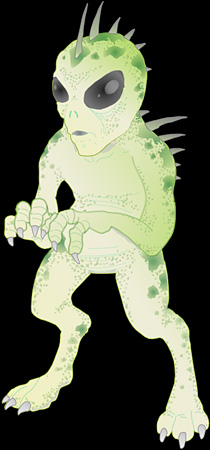
CHUPACABRA
The Chupacabra (literally "goat-sucker") is a contemporary legend, and a recent addition into Brazilian (and Latin American) folklore. It's a creature of supposedly alien origins, seen as responsible for the mysterious deaths of farm animals from which the blood has been drained. These animals typically exhibit a triangular pattern of three puncture wounds. Coincidentally, Chapada dos Guimarães (just north of the Pantanal) is South America's UFO capital. Over the past few decades, this location has had many sightings of mysterious lights, strange encounters, and some areas where wristwatches and electronics are said to stop functioning.
Those with an interest in ufology might be keen to learn about Brazil's most famous UFO incident (the Varginha Incident) which tool place several states away, in Varginha, Minas Gerais in 1996. This is when a mysterious horned devil-like creature (possibly a Chupacabra) was supposedly captured by the Brazilian Army. Some media reports claimed that a US Air Force transport plane was seen landing at the local air field shortly afterwards - and allegedly took the creature away to another undisclosed location. This case has gained notoriety amongst ufologists but, despite official inquiries and investigations, no further information has been released to the public.
Those with an interest in ufology might be keen to learn about Brazil's most famous UFO incident (the Varginha Incident) which tool place several states away, in Varginha, Minas Gerais in 1996. This is when a mysterious horned devil-like creature (possibly a Chupacabra) was supposedly captured by the Brazilian Army. Some media reports claimed that a US Air Force transport plane was seen landing at the local air field shortly afterwards - and allegedly took the creature away to another undisclosed location. This case has gained notoriety amongst ufologists but, despite official inquiries and investigations, no further information has been released to the public.



CURUPIRA
Curupira (also known as caipora) is a folklore character known throughout most of Brazil. The legend dats back at least to the16th century, and pre-European indian legends. This tells of a boy or dwarf with long bright red hair, whose feet point backwards to deceive or confuse those tracking him.
He's a protector of the forest - and is often held responsible for the disappearance of hunters, disturbance of traps, and loss of trails. He's also said to take retribution against those who needlessly destroy or harm the forests, animals or environment. Rubber tappers living and working in the Amazon region through into modern day, leave small gifts of cigarettes and cachaça on forest trails to help appease Curupira. He's often seen moving through the forest on the backs of animals such as peccaries (a type of wild boar) and tapirs.
He's a protector of the forest - and is often held responsible for the disappearance of hunters, disturbance of traps, and loss of trails. He's also said to take retribution against those who needlessly destroy or harm the forests, animals or environment. Rubber tappers living and working in the Amazon region through into modern day, leave small gifts of cigarettes and cachaça on forest trails to help appease Curupira. He's often seen moving through the forest on the backs of animals such as peccaries (a type of wild boar) and tapirs.
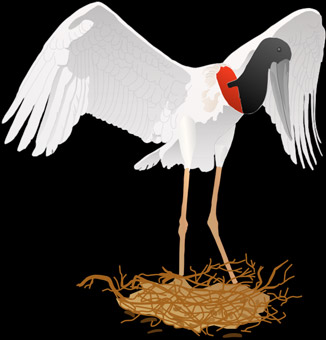
LEGEND OF THE TUIÚIÚ (JABIRU STORKS)
There's a legend relating to the Tuiúiú, or Jabiru Stork - the very large white, black and red stork which has become symbolic of the Pantanal wetlands. It's said that the sad appearance of the bird relates to a time in the past when it was frequently fed by a kind Indian couple. When this couple eventually died, they were buried in the spot where they fed the Tuiúiú - and that the Tuiúiú still return there, expecting the couple to re-appear and to feed them. However, since this has never happened, they become increasingly sad, searching for crumbs or just looking down towards the spot where the couple are buried.
This is why the storks seem to always be sad, looking toward the ground.
This is why the storks seem to always be sad, looking toward the ground.


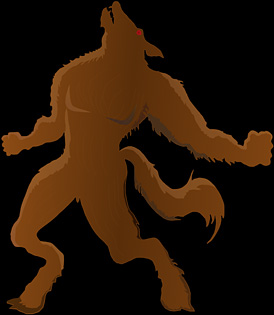
LOBISOMEM (WEREWOLF)
Brazil and the Portuguese settlers had their own werewolf legends. It was said that, in large families, the seventh son of the seventh son was destined to become a werewolf. The legend persists in Brazil, but modern versions of the story have now been heavily influenced by Hollywood versions. Notably, Brazil's own wolf (the Maned Wolf) is smaller and less scary than its North American and European cousins.
The town of Três Lagoas, located abut 200km from Campo Grande, is the location for one of Brazil's most enduring werewolf stories. Reports of an animal terrorising local residents gained national fame with television reports in the 1990s, interviewing numerous witnesses including police investigators. Hair samples were collected from barbed wire fences and sent away for analysis, but failed to yield any significant results. Occasional sightings are still reported in the town today.
The town of Três Lagoas, located abut 200km from Campo Grande, is the location for one of Brazil's most enduring werewolf stories. Reports of an animal terrorising local residents gained national fame with television reports in the 1990s, interviewing numerous witnesses including police investigators. Hair samples were collected from barbed wire fences and sent away for analysis, but failed to yield any significant results. Occasional sightings are still reported in the town today.



MÃOZÃO (BIG HANDS)
The legend of Mãozao is specific to the Pantanal and, in particular, the region of Nhecolândia. Mãozão was a slave working on a remote cattle ranch sometime during the 19th century. He was simple-minded and frequently abused by the harsh ranch owner. His greatest crime was to fall in love with the ranch owner's wife, who took pity on him. His punishment was being taken far out into the forest, in chains and tied to a tree using barbed wire, then abandoned.
Mãozão is still said to wander the remote countryside of the Pantanal, and is said to be responsible for strange occurrences where residents disappear without explanation, only to reappear several days later with little or no memory of what happened. In other ghost stories, witnesses and hunting dogs have returned with from the Pantanal looking much older and with all their hair turned white.
In some stories, Mãozão takes clear human form - whereas in others he's described as a bear-like beast covered in black hair.
Mãozão is still said to wander the remote countryside of the Pantanal, and is said to be responsible for strange occurrences where residents disappear without explanation, only to reappear several days later with little or no memory of what happened. In other ghost stories, witnesses and hunting dogs have returned with from the Pantanal looking much older and with all their hair turned white.
In some stories, Mãozão takes clear human form - whereas in others he's described as a bear-like beast covered in black hair.



MINHOCÃO
The Minhocão has much in common Boiúna or Cobra Grande (Great Snake) of the Amazon region. Minhocão is a kind of long snake which some say is responsible for the creation of the region's many rivers, where he still lives under the clay banks. Due to his immense head, he leaves marks or furrows on the ground when he travels - which may eventually become future rivers or streams.
Whenever Minhocão gets angry or hungry, he creates bends and whirlpools in the river to trap canoes and fishermen - devouring them as they sink. It's said that people who witness such an attack are sometimes overcome with terror and driven mad.
Whenever Minhocão gets angry or hungry, he creates bends and whirlpools in the river to trap canoes and fishermen - devouring them as they sink. It's said that people who witness such an attack are sometimes overcome with terror and driven mad.


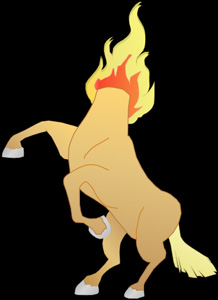
MULA SEM CABEÇA (HEADLESS MULE)
The legend of the Headless Mule is common throughout Brazil. This is said to be the form taken by women each night from Thursday to Saturday as punishment for having become the mistress of a priest. The mule's head is replaced with a fiery flame although sometimes still with a discernible shape. The mule is expected to run across seven parishes each night before returning to its human form in the morning.
The curse can supposedly be broken if someone is brave enough to reach into the fire and remove the halter from the mule's fiery head.
The curse can supposedly be broken if someone is brave enough to reach into the fire and remove the halter from the mule's fiery head.


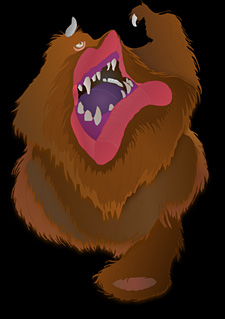
PÉ DE GARRAFA (BOTTLE FOOT)
This legend takes several forms in different locations around Brazil. Various descriptions include:
- A beast half man and half horse - like a centaur,
- A beast shaped like a man and covered with hair, except for a bare spot around the navel region,
- A horse-like creature with an eye in the middle of its forehead
- A bear-like creature covered in red or brown hair. This is the version reported by Indian tribes of northern Brazil and may be linked to their legend of the similarly described Mapinguari.


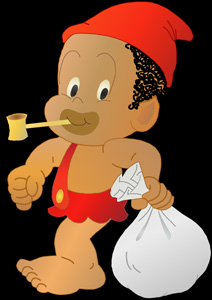
SAÇI-PERERÊ
Saçi (pronounced [saˈsi]) is one of the most popular characters in Brazilian folklore. He's a one-legged black or mulatto child or dwarf, who smokes a pipe and wears a magical red cap that enables him to disappear and reappear wherever he wishes. He's usually said to travel in a mini-tornado or dust-devil.
He's considered an annoying prankster in most parts of Brazil, and potentially dangerous or malicious elsewhere. The loss or disappearance of possessions is sometimes blamed on Saçi - with it's return sometimes requiring small rituals to appease the spirit Nonetheless, wishes can be granted to anyone who manages to trap him or steal his cap. However, this involves some danger as there's more than one saçi - and he can potentially invoke his friends for help.
He's considered an annoying prankster in most parts of Brazil, and potentially dangerous or malicious elsewhere. The loss or disappearance of possessions is sometimes blamed on Saçi - with it's return sometimes requiring small rituals to appease the spirit Nonetheless, wishes can be granted to anyone who manages to trap him or steal his cap. However, this involves some danger as there's more than one saçi - and he can potentially invoke his friends for help.



SINHOZINHO
The region of Bonito has its own legend relating to a friar who preached in the region during the 1930s but then mysteriously disappeared. The friar was small and mute - but was still able to communicate even without having a voice. It's also reported that he miraculously cured many local residents from injuries and sickness.
Even though he vanished without a trace, its said that he still wanders through the region, marked by crosses and signs in the chapel that he built. There are many different versions of the story - with one version claiming that he's trapped underneath a hill near the town, locked in an eternal battle with a giant snake which threatens to destroy the town and devour its townspeople if ever released.
Even though he vanished without a trace, its said that he still wanders through the region, marked by crosses and signs in the chapel that he built. There are many different versions of the story - with one version claiming that he's trapped underneath a hill near the town, locked in an eternal battle with a giant snake which threatens to destroy the town and devour its townspeople if ever released.










Image credits: Spectacled Caiman (Shutterstock/Dirk Ercken)
Bandeirante, Sunset, and Kingfisher (Andrew Mercer)
Pantanal Escapes